19 Types of Garnish for Top-Tier Plating & Presentation
Author: Anne Cowart | Editor: Omar Alonso
Review & Research: Jen Worst & Chris Miller

Often, types of garnish are thought to be unnecessary and frivolous, but they are what draw you to the dish by adding visual appeal to it.
Let’s face it—that sprig of mint that just came with your drink is going to be brushed aside in a second, but you can’t deny the fact that your drink looks so much better with that mint sprig.
You’re more likely to eat a well-garnished bread-and-eggs breakfast than two plain slices of toast and an omelet, even if the latter is super delicious.
You see, visuals matter in the world of food—the more visually appealing the platter, the more likely you are to eat the food on it. Garnishes, as you are well aware, add a ton of visual appeal to food—not to mention making you seem Master-Chef-level impressive.
19 Types of Garnish
Some of the benefits of garnish in cooking include greatly enhancing the visual appeal of a dish, enhancing the flavor profile of a plate or course, visually filling the plate if the arrangement of the food seems scarce (even when it isn't), and helping people identify what a dish is by following conventions in plating.
If you’re getting into the garnish game, here’s a breakdown of the different garnish types, from fruits to herbs to peels, that you can use.
Herbs & Leaves
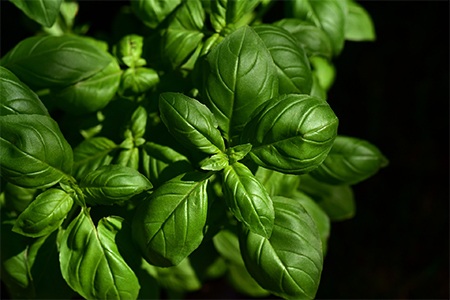
Herbs and leaves are the most commonly used garnishes, adding color and an unbeatable, distinct, mouth-watering aroma to the dishes.
They’re also the most varied—there are multiple garnishing possibilities with herbs and leaves. Herbs and leaves can be used fresh or dried for garnishing.
Basil

Basil is among the most commonly used leaves for garnishing purposes. Found aplenty between November and April, there are many different types of basil, each with a different level of flavor.
Some of the commonly used varieties include lettuce leaf basil (large green leaves), dark opal (dark purple leaves), fino verde (with small leaves) and Thai basil.
Basil adds a strong sweet-and-spicy flavor to the dish, making it a popular addition to salads and savory dishes. ‘Basil and tomato’ is a star combination and the basis of pesto recipes across the world.
Bay Leaves
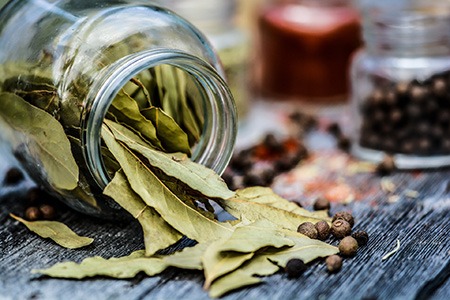
Another popular garnishing option is bay leaves, used to flavor everything from soups to stews to stocks to braises to marinades. These are generally added for flavor and removed while eating.
Chives

Chives are another commonly-used garnish option, available from September to May. A part of the onion family but less pungent, they are quite a versatile herb, used with salads, egg dishes, vegetables and meats.
Ensure that you add chives only just before serving, as these are heat sensitive. Garlic chives are another popular option. If you want to know how to grow chives and have an endless supply, we have the answers.
Sorrel
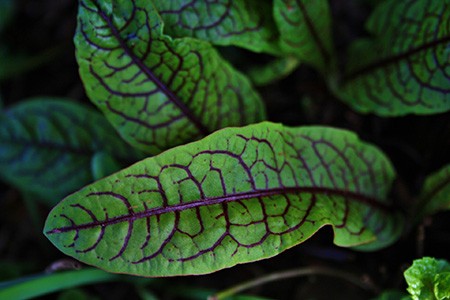
Sharp-tasting, tangy and refreshing, sorrel leaves are used in soups, omelets, salads and sauces and very often as a replacement for most types of spinach. The leaves of these types of garnish are quite good looking, very similar to baby spinach and add instant flavor to the dish.
Thyme

Thyme comes in many varieties—fresh, dried, lemon, standard and so on. Lemon and standard thyme, commonly available, can be used cooked or raw, in soups, stuffing, braises, stews, salads and with meat. Fresh sprigs can be added to oil or vinegar for a delicious dressing or marinade.
Coriander / Cilantro
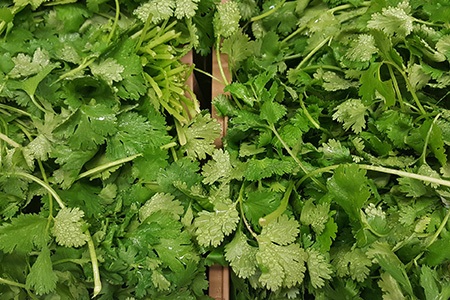
A staple in Indian, Thai, and Chinese cuisine, fresh coriander leaves are used in sauces, curries, salads, stir fries and to make delicious chutneys. These various types of cilantro are among the most obvious examples of garnishes.
The seeds are also staple types of spices in many South-East Asian households (whole or ground) and the roots and stems are also used.
Lemongrass

Another common ingredient in South-East Asian cuisine, lemongrass roots and leaves are used as types of garnishes. These add a great aroma to the dish.
Parsley

Similar to coriander, parsley is a super-versatile herb that can be used in a range of dishes. All of the types of parsley can be used chopped or in sprigs for garnishing and is best added at the end to preserve flavor. Italian parsley and standard parsley are two common garnish types.
Oregano

Mamma mia—no list of herbs is complete without at least one of the types of oregano. Used in pizzas, salads, mayonnaise, rice, omelets and with vegetables, oregano makes a delicious couple with eggplant, tomatoes, potatoes and courgettes.
Oregano is also known as marjoram in some parts and comes in many varieties, so please explore many of these types of garnish and don't get turned off by any single attempt. It's wildly popular.
Mint

An herb that’s popular around the world, mint is used in salads, desserts, water, juices, cocktails and a seemingly endless list of other dishes.
Mint can be paired with a range of other flavors and comes in a range of varieties such as peppermint, apple mint and spearmint. This herb is available around the year.
Sage

A versatile herb, sage’s strong flavor warrants only small quantities in dishes—bread, stews, quiches, dressings, soups, pulses, stews and the like.
Whole leaves are commonly used with skewers of vegetables and meats. Sage is available in different varieties, such as standard, sweet and pineapple sage. Grow sage in your herb spiral for lasting enjoyment.
Rosemary

Another extremely strong herb, rosemary is used sparingly with meats and most commonly in marinades and stuffing.
Generally added at the beginning of the cook, so that the flavor permeates, rosemary can be used dried or as whole leaves. Its purple flowers can also be used as types of garnishes.
You can also put rosemary in vinegar or oil, which, in turn, can be used to flavor salads. Apart from these, there are many other herbs and leaves, such as curly kale, tarragon and dill.
Roots

Roots also make great garnishes. Horseradish, for example, can be used grated or peeled, with a hot taste, or even enjoyed as one of the types of mustard available.
They can also be mixed with vinegar, lemon juice and sour cream or grated and added to salads and steamed vegetables. Young leaves can be used in sandwiches and salads.
Wasabi is another popular root, often eaten as a pungent green paste with sashimi or alongside many types of sushi with soy sauce. A staple of Japanese cuisine, wasabi leaves are finely chopped and used, while stems are used in preserves. These types of garnish are even popular in the states now.
Syrups & Sauces
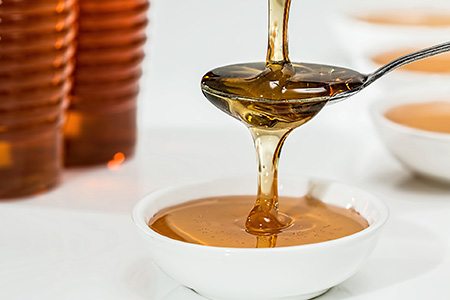
Sauces like teriyaki, BBQ, southwest and others are great examples of garnishes, especially on meats simmering in any types of smokers, grills, or ovens. Sauces like strawberry and chocolate are great for desserts.
Kids, especially, love a healthy splash of chocolate sauce and will eat almost anything with chocolate sauce on it. Little do those little dummies know that they're enjoying garnish types they'd otherwise reject!
Veggies & Fruits
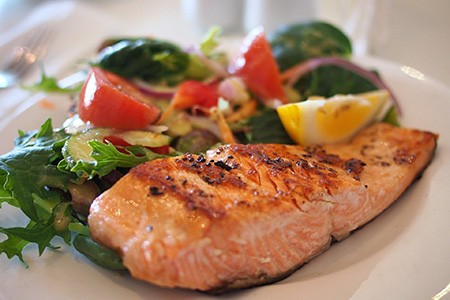
Lemon wedges, watermelon slices, orange peel, whole berries, tomatoes, types of radishes, and all types of grapes all make great garnishes. Fruits and vegetables, whole and sliced, are great options for garnishing.
Many citrus fruits are used as slices, wedges or for their zest, whereas fruits like tomatoes, especially cherry tomatoes, are used whole.
Some of the popular garnishing options with fruits and veggies are:
- Lime quarters
- Orange and lime zest
- Pineapple pieces
- Any types of watermelon chunks
- Lemon spirals
- Thin slices of fruits and vegetables, like julienne carrots
You can also use deep-fried vegetables or shavings of deep-fried vegetables as types of garnish, as well as deep-fried or roasted bread cubes.
Purees
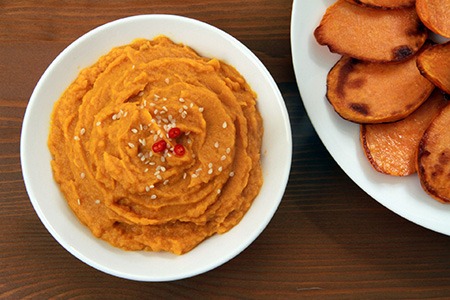
Purees of fruits and vegetables are also commonly used to garnish dishes. They can either be poured over like a sauce or spread out on the platter. Tomato puree is a highly popular garnish. Purees can bring flavor, texture and color to the dish.
Nuts

Nuts are a great option as types of garnishes, in both dessert and savory dishes. Roasted and/or sliced nuts are great with ice cream, in cakes and their types of frosting, a range of sweet dishes, as well as in rice dishes. Seeds are another great option, either raw or roasted. Too add an interesting flavor, choose various types of pecans before other nuts.
Edible Flowers
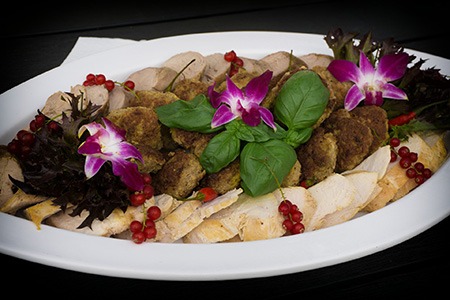
Off late, the trend of using edible flowers to garnish dishes has taken over many professional kitchens around the world. Chefs use a range of delicious flowers, ranging from types of jasmine flowers to pansies to calendula, as a garnish.
An edible flower provides a nice pop of color to the dish and you can either use seasonal or perennial flowers as types of garnish.
Pansies and calendula, for example, are available throughout the year, whereas other flowers such as nasturtiums are only available from September to April.
Heart’s ease pansies, with their rich, deep purple tones, add a regal, luxurious touch to any dish. The petals of calendula flowers are very commonly used in salads—most folks only use these for their color, though, since they are quite lacking in their flavor.
Certain types of marigolds are another popular option, available between November and April. Similar to calendula, these flowers can also be used as a substitute for saffron for a bright yellow shade, especially in rice dishes. Additionally, they can also be used in salads.
Though very similar to pansies in their looks and fragility, Nasturtiums are a popular option because of their vibrant orange, red and yellow hues, with leaves that add a peppery zing to the dish and seeds that can give capers a run for their money, especially pickled.
Cornflowers are another popular option. In bloom between November and May, these bright purple flowers are also found in white and pink shades.
Rounding off the ‘popular’ list are the types of verbena, in bloom between December and April. Verbena, available in pink, red and white, adds a subtle lemony zing to the dish.
Types of Garnish for Every Dish
When it comes to types of garnish, there are no hard and fast rules—anything that’s edible, delicious and presented right can be used as a garnish types. The kitchen is your oyster, so don’t restrict yourself to just the commonly used herbs—let your imagination (and taste buds) go wild.




